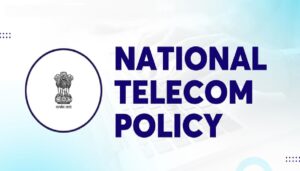GS 2 – Governance

Context:
The Ministry of Communications has introduced the Draft National Telecom Policy (NTP) 2025, which includes incentives to promote the use of domestically manufactured telecom equipment.
About Draft National Telecom Policy (NTP) 2025
The Draft NTP 2025 is a progressive policy framework developed by the Department of Telecommunications (DoT) to guide India’s telecommunications sector from 2025 to 2030. It emphasizes self-reliance (Atmanirbhar Bharat), universal connectivity, and the adoption of advanced technologies such as 6G and quantum communication.
Key Features of Draft NTP 2025
- Promotion of Domestic Telecom Equipment
- Encourages telecom operators to use locally manufactured equipment by offering incentives.
- Aims to boost Indian manufacturers like Tejas Networks and HFCL.
- Targets reducing telecom imports by 50% through indigenous production.
2.Research & Development (R&D) and Intellectual Property (IP) Growth
- Plans to increase India’s telecom R&D spending twofold.
- Supports 500 technology startups and aims to secure 10% of global 6G-related patents.
- Promotes innovation through blended financing and fund-of-fund models.
3.Infrastructure Expansion & Universal Connectivity
- Aims for 100% 4G and 90% 5G coverage by 2030.
- Enhances tower fiberization from 46% to 80%.
- Ensures full connectivity for all gram panchayats via BharatNet with 98% uptime.
- Expands fixed-line broadband to 100 million households and installs 1 million public Wi-Fi hotspots.
4.Employment and Skill Development
- Targets creating 1 million new jobs in the telecom sector.
- Focuses on upskilling 1 million professionals in emerging telecom technologies.
5.Export and Investment Goals
- Aims to double telecom product and service exports.
- Seeks to attract ₹1 trillion in annual investments for the telecom industry.
6.Secure and Trusted Networks
- Proposes audits to eliminate untrusted telecom hardware, prioritizing national security.
- Emphasizes quantum-secure communication systems.
7.Green Telecom Initiatives
- Commits to reducing the telecom sector’s carbon emissions by 30%.
- Focuses on sustainable infrastructure deployment and integration of clean energy solutions.
Significance of the Policy
- Strengthening Domestic Telecom Manufacturing: Reinforces the Make-in-India initiative, reducing dependence on Chinese imports.
- Reducing the Digital Divide: Bridges the rural-urban connectivity gap through extensive fiberization and public Wi-Fi expansion.
- Addressing Past Policy Gaps: Recognizes shortcomings in the Production Linked Incentive (PLI) scheme and introduces corrective measures.
- Preparing for Global Technological Leadership: Positions India as a key player in 6G development through startup support and IP generation.
- Comprehensive Sectoral Reform: Integrates connectivity, innovation, investment, and national security into a unified vision.
The Draft NTP 2025 represents a strategic shift toward self-sufficiency, technological innovation, and secure telecom infrastructure. By setting ambitious targets and addressing previous policy challenges, it aims to establish India as a global telecom leader. However, its success will depend on effective implementation and industry-wide collaboration.




